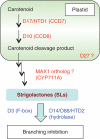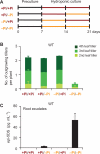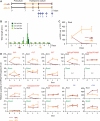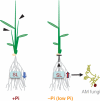Contribution of strigolactones to the inhibition of tiller bud outgrowth under phosphate deficiency in rice
- PMID: 20542891
- PMCID: PMC2900824
- DOI: 10.1093/pcp/pcq084
Contribution of strigolactones to the inhibition of tiller bud outgrowth under phosphate deficiency in rice
Abstract
Strigolactones (SLs) or SL-derived metabolite(s) have recently been shown to act as endogenous inhibitors of axillary bud outgrowth. SLs released from roots induce hyphal branching of arbuscular mycorrhizal (AM) fungi that facilitate the uptake of inorganic nutrients, such as phosphate (Pi) and nitrate, by the host plants. Previous studies have shown that SL levels in root exudates are highly elevated by Pi starvation, which might contribute to successful symbiosis with AM fungi in the rhizosphere. However, how endogenous SL levels elevated by Pi starvation contribute to its hormonal action has been unknown. Here, we show that tiller bud outgrowth in wild-type rice seedlings is inhibited, while root 2'-epi-5-deoxystrigol (epi-5DS) levels are elevated, in response to decreasing Pi concentrations in the media. However, the suppression of tiller bud outgrowth under Pi deficiency does not occur in the SL-deficient and -insensitive mutants. We also show that the responsiveness to exogenous SL is slightly increased by Pi deficiency. When Pi-starved seedlings are transferred to Pi-sufficient media, tiller bud outgrowth is induced following a decrease in root epi-5DS levels. Taken together, these results suggest that elevated SL levels by Pi starvation contribute to the inhibition of tiller bud outgrowth in rice seedlings. We speculate that SL plays a dual role in the adaptation to Pi deficiency; one as a rhizosphere signal to maximize AM fungi symbiosis for improved Pi acquisition and the other as an endogenous hormone or its biosynthetic precursor to optimize shoot branching for efficient Pi utilization.
Figures






Similar articles
-
Cytokinin catabolism and transport are involved in strigolactone-modulated rice tiller bud elongation fueled by phosphate and nitrogen supply.Plant Physiol Biochem. 2024 Oct;215:108982. doi: 10.1016/j.plaphy.2024.108982. Epub 2024 Jul 29. Plant Physiol Biochem. 2024. PMID: 39089046
-
Strigolactones: Internal and external signals in plant symbioses?Plant Signal Behav. 2013 Mar;8(3):e23168. doi: 10.4161/psb.23168. Epub 2013 Jan 8. Plant Signal Behav. 2013. PMID: 23299321 Free PMC article.
-
FINE CULM1 (FC1) works downstream of strigolactones to inhibit the outgrowth of axillary buds in rice.Plant Cell Physiol. 2010 Jul;51(7):1127-35. doi: 10.1093/pcp/pcq083. Epub 2010 Jun 14. Plant Cell Physiol. 2010. PMID: 20547591 Free PMC article.
-
On the outside looking in: roles of endogenous and exogenous strigolactones.Plant J. 2021 Jan;105(2):322-334. doi: 10.1111/tpj.15087. Epub 2020 Dec 24. Plant J. 2021. PMID: 33215770 Review.
-
The importance of strigolactone transport regulation for symbiotic signaling and shoot branching.Planta. 2016 Jun;243(6):1351-60. doi: 10.1007/s00425-016-2503-9. Epub 2016 Apr 4. Planta. 2016. PMID: 27040840 Free PMC article. Review.
Cited by
-
OsASN1 Plays a Critical Role in Asparagine-Dependent Rice Development.Int J Mol Sci. 2018 Dec 31;20(1):130. doi: 10.3390/ijms20010130. Int J Mol Sci. 2018. PMID: 30602689 Free PMC article.
-
Identification of two oxygenase genes involved in the respective biosynthetic pathways of canonical and non-canonical strigolactones in Lotus japonicus.Planta. 2020 Jan 6;251(2):40. doi: 10.1007/s00425-019-03332-x. Planta. 2020. PMID: 31907631
-
Unlocking the Multifaceted Mechanisms of Bud Outgrowth: Advances in Understanding Shoot Branching.Plants (Basel). 2023 Oct 20;12(20):3628. doi: 10.3390/plants12203628. Plants (Basel). 2023. PMID: 37896091 Free PMC article. Review.
-
Comparative transcriptome analyses reveal different mechanism of high- and low-tillering genotypes controlling tiller growth in orchardgrass (Dactylis glomerata L.).BMC Plant Biol. 2020 Aug 5;20(1):369. doi: 10.1186/s12870-020-02582-2. BMC Plant Biol. 2020. PMID: 32758131 Free PMC article.
-
Transcriptome Analysis Reveals the Potential Molecular Mechanisms of Tiller Bud Development in Orchardgrass.Int J Mol Sci. 2023 Oct 30;24(21):15762. doi: 10.3390/ijms242115762. Int J Mol Sci. 2023. PMID: 37958746 Free PMC article.
References
-
- Akiyama K., Matsuzaki K., Hayashi H. Plant sesquiterpenes induce hyphal branching in arbuscular mycorrhizal fungi. Nature. 2005;435:824–827. - PubMed
-
- Amtmann A., Armengaud P. Effects of N, P, K and S on metabolism: new knowledge gained from multi-level analysis. Curr. Opin. Plant Biol. 2009;12:275–283. - PubMed
-
- Arite T., Iwata H., Ohshima K., Maekawa M., Nakajima M., Kojima M., et al. DWARF10, an RMS1/MAX4/DAD1 ortholog, controls lateral bud outgrowth in rice. Plant J. 2007;51:1019–1029. - PubMed
-
- Arite T., Umehara M., Ishikawa S., Hanada A., Maekawa M., Yamaguchi S., et al. d14, a strigolactone-insensitive mutant of rice, shows an accelerated outgrowth of tillers. Plant Cell Physiol. 2009;50:1416–1424. - PubMed
-
- Beveridge C.A., Kyozuka J. New genes in the strigolactone-related shoot branching pathway. Curr. Opin. Plant Biol. 2010;13:34–39. - PubMed
Publication types
MeSH terms
Substances
LinkOut - more resources
Full Text Sources
Research Materials
Miscellaneous

